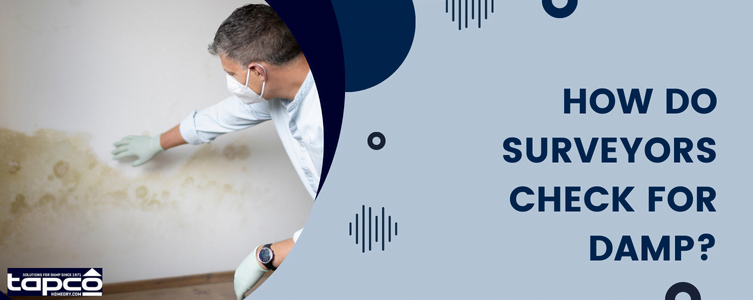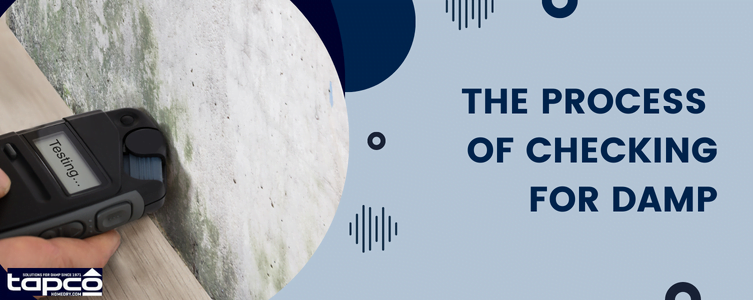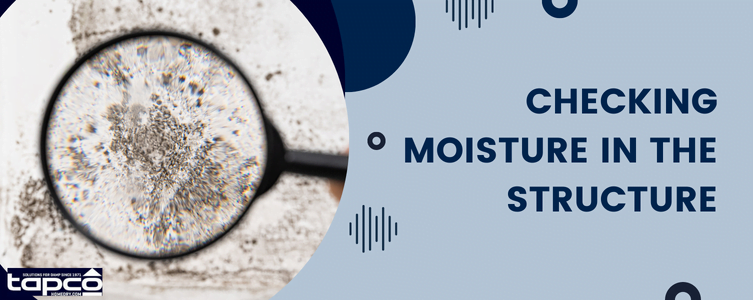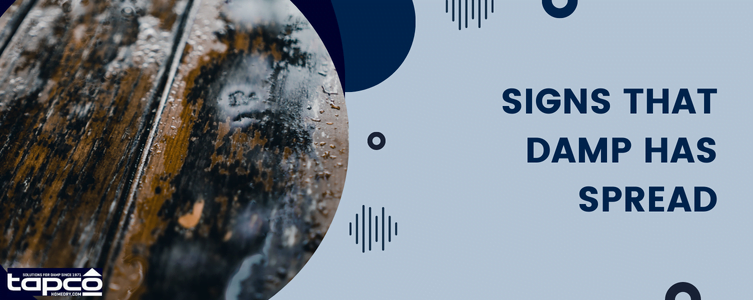
A home survey is essential before buying or selling a property. It helps to confirm there aren’t any structural issues with the property that could damage its value in the future. This helps to protect lenders and borrowers from the risk of purchasing a property that could quickly decline in value.
Homeowners are sometimes surprised to learn that surveyors use a number of methods to check for damp when conducting a home survey. Here, we’ll explain the different ways surveyors test for moisture in properties. Understanding how damp is diagnosed can help you be better prepared for any potential problems that may be uncovered during a house purchase.

How do surveyors check for damp?
The first thing a surveyor will do is check the property for any obvious signs of damp, such as peeling wallpaper or flaking paint. These are often the first visual hints of dampness in a property.
Telltale signs of damp can range from discoloured walls, streaks on paintwork, or large watermarks. Peeling wallpaper or flaking paint are also common signs of excess moisture that could cause serious damage if left unchecked.
Similarly, musty odours and condensation building up in areas without adequate ventilation are early warning signs of damp that should be addressed right away. The surveyor’s job is to diagnose the extent of damage and recommend the necessary repairs before they become costly issues.

Checking moisture in the structure
They will then use a moisture meter to check the level of dampness in the walls, floors and ceilings. Checking the moisture levels of walls, floors and ceilings is an important step in any sale process. This can help to spot the early signs of rising damp before it becomes more obvious and outwardly visible.
Moisture meters can provide accurate readings, giving builders and homeowners a reliable way to check for signs of dampness or water damage. If a spot is too damp, this would require further investigation to identify the source of the moisture. Surveyors are looking for structural problems that could impact the value of the house in the future. Rising damp and dry rot are two common issues that surveyors are looking for.
Knowing where problems exists helps to cut down on future repairs and make the overall process more efficient. If you discover a damp problem during your home sale, you can decide whether you would like to list your home at a lower price, or fix the issue before you move forward. Since damp could knock between 10% and 50% off the value of your property, it’s often more efficient to deal with the damp before you sell your home.
If you are buying a property and discover a rising damp problem, you could use this information to negotiate a lower price.

Signs that damp has spread
Surveyors will also look for any mould growth, which can be a sign of dampness. When surveying the home, surveyors will look closely for any signs of dampness caused by mould growth.
If found, they will assess how it is affecting the property and advise next steps such as repairs and/or possible treatments. Mould can spread quickly, especially when not detected in time, so it’s important to have a thorough inspection to identify any issues.
Dampness that goes untreated could cause wood rot or encourage infestation by pests; both of which can lead to more costly repairs down the road. All in all, examining the home for signs of dampness is paramount for a successful survey assessment.

The homeowner’s experience is key
Finally, they will ask the occupants of the property about any problems they have experienced with dampness, such as musty smells or condensation on windows. During any property inspection, a potential buyer or professional surveyor will investigate the possibility of dampness.
They can detect visible signs like peeling wallpaper or discoloured patches on the walls or flooring. Additionally, they will assess the level of humidity in different parts of the building using special devices and inquire about problems such as condensation on windows or musty smells associated with dampness.
Taking all this into account, these observers can determine whether further assessment is necessary to prevent long-term damage and repair any current issues. In short, the homeowner’s experience in the property can help to inform the extent of the damage.
Conclusion
Dampness in a property can cause many problems for the occupants, such as musty smells, mould growth and condensation on windows. If you suspect that your property is suffering from damp, it is important to have a surveyor check it out as soon as possible. By carrying out a thorough examination of the property and speaking to the occupants, they will be able to identify the cause of the damp and advise you on the best course of action to take before you buy or sell a property.


 Damp Proofing
Damp Proofing Basement Damp Proofing
Basement Damp Proofing Water Damage
Water Damage Condensation Control
Condensation Control Dry Rot Treatment
Dry Rot Treatment WOODWORM & WET ROT
WOODWORM & WET ROT CAVITY Wall Ties
CAVITY Wall Ties Property Maintenance
Property Maintenance Waterproofing And Tanking
Waterproofing And Tanking Structural Repairs
Structural Repairs







